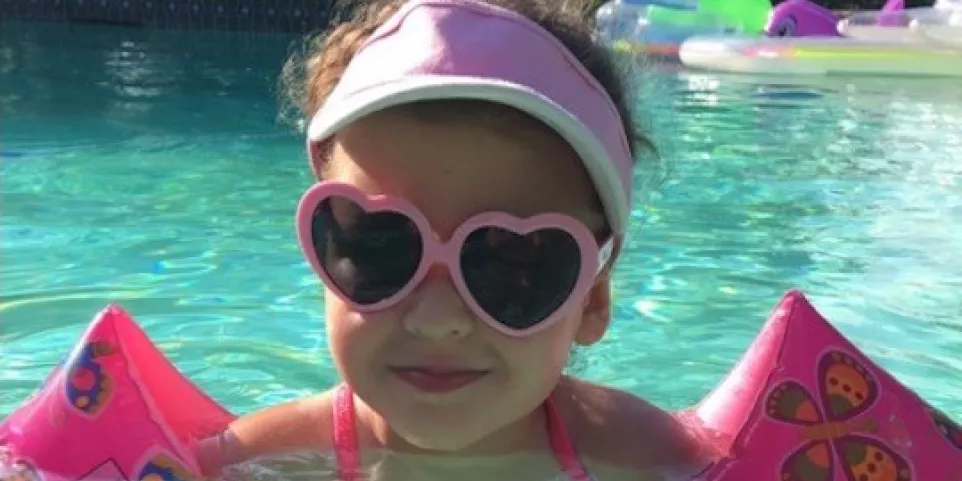Our long journey to a SON diagnosis


She feels invincible with her floaties on. I smiled as I thought of my beautiful 7 year-old daughter, Kylie, who enjoys swimming and started public school this fall. I am filled with enormous joy and pride at how far she has come.
Kylie is our only child and my pregnancy was fairly smooth until around the 30th week when my doctor noticed the fetus was growing slowly. Since I was also being closely monitored for placenta previa, a condition in which the baby’s placenta partially or fully covers the opening in the mother’s cervix, my gynecologist decided that delivering the baby via an emergency C-section was the best course of action.
Kylie entered the world on a warm spring day as a 32-week, premature baby and spent the next three months in the neonatal intensive care unit (NICU) at Texas Children’s Hospital recuperating from birth-related respiratory distress. Once she was back home, we noticed Kylie was delayed in meeting her milestones – she crawled only at 22 months and did not walk until she was 4 ½ years! All of us, including the doctors, chalked up these delays to her prematurity and birth trauma.
Then she started having seizures, initially just once a year, but by the time she was 3, they were occurring pretty frequently. In fact, there was a day when she had 24 brief episodes within a 24-hour period. She had vision problems and feeding issues. She has always been a happy and alert child, but she was mostly non-verbal except for a few sporadic phrases.
Initially, we thought only her lungs had been damaged at birth, but slowly it became apparent that her brain and nervous system were also affected. Eventually, once it was clear that prematurity was not the only reason behind her symptoms, we had her tested for various childhood neurological disorders – cerebral palsy, autism, Down syndrome and many others, but they all came back negative.
We were getting desperate to get a specific diagnosis for Kylie, but it was a long quest that took us several years.
In 2013, we met and consulted with Dr. Christian Schaaf, a molecular geneticist at Texas Children’s. Recently, he had identified genetic mutations responsible for two new neurological disorders, the Schaaf-Yang syndrome and Bosch-Boonstra-Schaaf optic atrophy syndrome, and we felt very hopeful that he may be able to find an answer for Kylie’s mysterious condition.
One of the tests Dr. Schaaf performed was whole exome sequencing, which checks for misspellings in the genetic code of more than 20,000 protein-coding genes in the genome. However, the test came back without an answer. Several misspellings were identified, but none of them could explain Kylie’s neurological disease, at least not at that time.
It took several more years of extensive research, and exome analyses on thousands of additional patients, before Dr. Schaaf, in collaboration with Dr. Magdalena Walkiewicz and her team at Baylor College of Medicine, found that Kylie and other children with similar neurological features all had misspellings or missing parts in one common gene, the “SON” gene. Since then, I learned this gene is essential for a fundamental biological process in all tissues, and loss of crucial parts of the SON gene results in multi-organ pathologies.
Getting this specific diagnosis has been a huge blessing for us and for Kylie. Before, Kylie was a “mystery kid” and we did not know what milestones to expect from her next. However, now, thanks to Dr. Schaaf’s study, we have been able to connect with other families whose children have SON mutations. Recently, we spent a few days in Morgan’s Wonderland, an amusement park for special needs kids in San Antonio, Texas, with two SON families. Watching Kylie play with a child who is exactly like her but just a few years older, gave me a glimpse to future milestones I could hope to see in my daughter and prepare for her care – a precious gift for this mom!
I am very hopeful for Kylie and other children/young adults like her because I have personally experienced the dedication and persistence of geneticists like Dr. Schaaf. Also, I have seen the exciting advances in genomics that have taken place in the past few years which made techniques like exome sequencing accessible and affordable for patients like us.
In fact, if you had given up hope of getting a specific diagnosis for your child after years of testing, I urge you to please go back and consult with your geneticist/neurologist about getting tested again, using cutting-edge genomic diagnostic methods like exome sequencing.
Remember, together we can find a specific diagnosis and, perhaps, also a cure for our children someday.